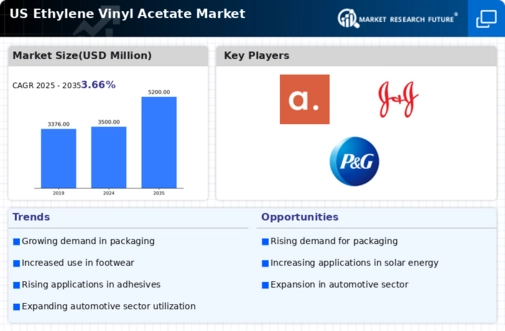The ethylene vinyl acetate market exhibits a dynamic competitive landscape characterized by innovation and strategic positioning among key players. Major companies such as DuPont (US), ExxonMobil (US), and LyondellBasell (US) are actively shaping the market through various operational focuses. DuPont (US) emphasizes sustainability and innovation, particularly in developing eco-friendly EVA products, which aligns with the growing demand for sustainable materials. ExxonMobil (US) leverages its extensive supply chain capabilities to enhance production efficiency, while LyondellBasell (US) focuses on strategic partnerships to expand its product offerings and market reach. Collectively, these strategies contribute to a competitive environment that is increasingly driven by technological advancements and sustainability initiatives.
Key business tactics within the market include localizing manufacturing and optimizing supply chains to enhance responsiveness to customer needs. The competitive structure appears moderately fragmented, with several players vying for market share. However, the influence of major companies is substantial, as they set industry standards and drive innovation. This competitive dynamic encourages smaller players to adopt niche strategies or seek partnerships to remain relevant in the evolving landscape.
In November 2025, DuPont (US) announced a partnership with a leading renewable energy firm to develop bio-based EVA products. This strategic move is significant as it positions DuPont (US) at the forefront of the sustainable materials trend, potentially capturing a larger share of the eco-conscious consumer market. The collaboration is expected to enhance DuPont's product portfolio and reinforce its commitment to sustainability, which is increasingly becoming a key differentiator in the market.
In October 2025, ExxonMobil (US) unveiled a new production facility aimed at increasing its EVA output by 20%. This expansion is crucial as it not only meets the rising demand for EVA in various applications but also enhances ExxonMobil's competitive edge through improved economies of scale. The facility is expected to utilize advanced manufacturing technologies, further solidifying ExxonMobil's position as a leader in the market.
In September 2025, LyondellBasell (US) completed the acquisition of a specialty chemicals company, enhancing its capabilities in producing high-performance EVA products. This acquisition is strategically important as it allows LyondellBasell (US) to diversify its product offerings and cater to a broader range of applications, thereby strengthening its market position. The integration of the acquired company's technologies is anticipated to drive innovation and improve operational efficiencies.
As of December 2025, current competitive trends in the ethylene vinyl acetate market are increasingly defined by digitalization, sustainability, and the integration of AI technologies. Strategic alliances are becoming more prevalent, as companies recognize the value of collaboration in driving innovation and enhancing supply chain reliability. The competitive landscape is shifting from traditional price-based competition to a focus on technological advancements and sustainable practices. This evolution suggests that companies that prioritize innovation and adaptability will likely emerge as leaders in the market.














Leave a Comment